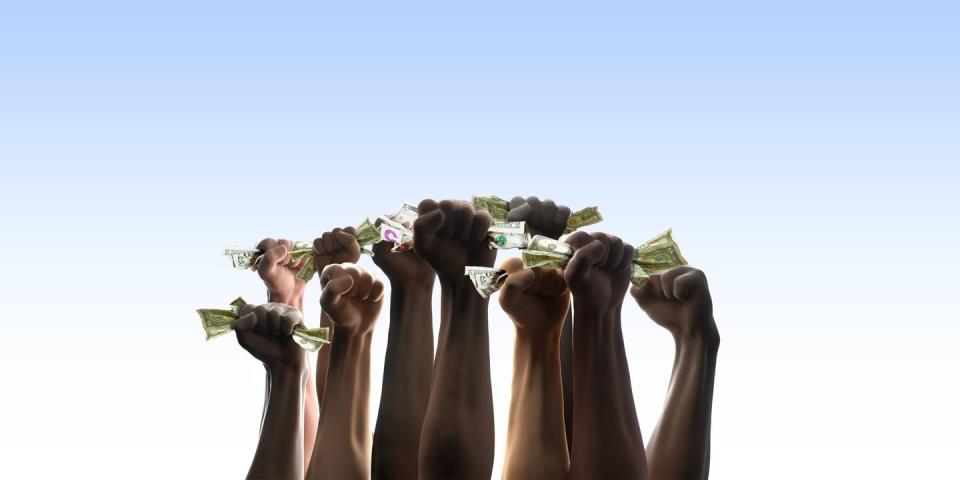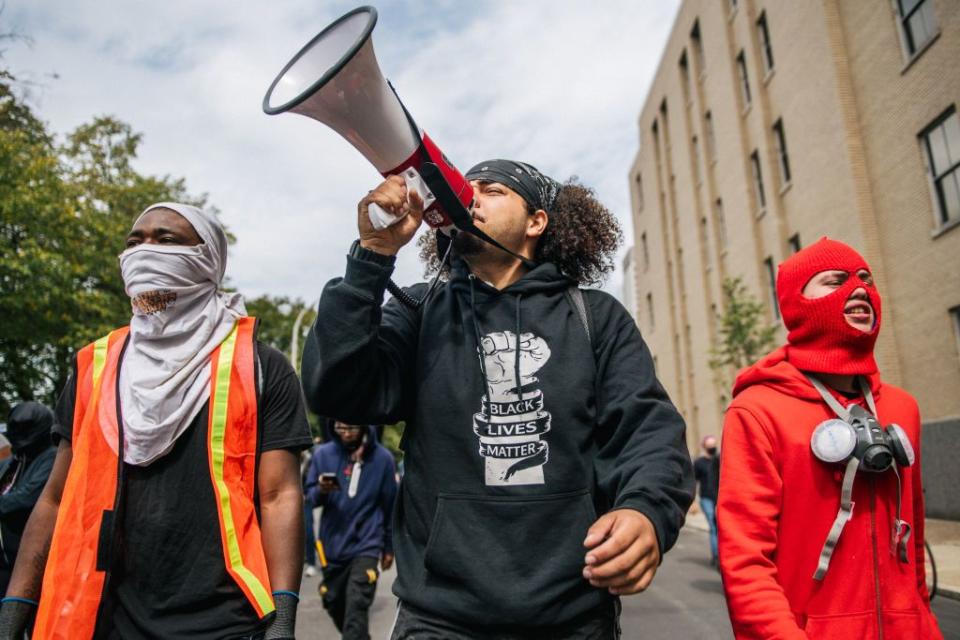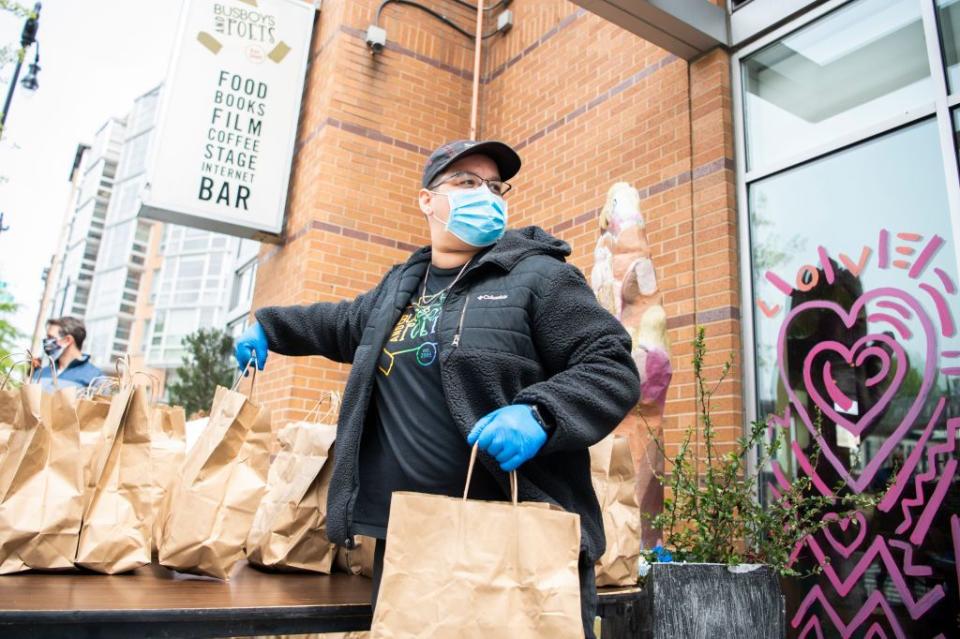The Power of Black Giving


When the protestors hit the streets, the money started moving. Not by corporations, not by the brand you buy your underwear from—that happened later, if it happened at all. It began during the last days of May, in the cities where cops faced off against peaceful protestors as if they were an invading army. It started moving in $5, $25, $50 increments, from the bank accounts of the underpaid to the bank accounts of the underfunded. A Venmo payment to a local bail organization. A GoFundMe contribution to the family of a barbecue restaurant owner gunned down by law enforcement in Louisville. A donation to a nonprofit advocating for Black trans people in Atlanta. Dollars gathered to ensure Black journalists have access to mental health resources. Later, to a GoFundMe account set up by Jacob Black's mother and the Milwaukee Freedom Fund to bail out protestors in Kenosha.
And last night, after Breonna Taylor was denied justice yet again in a grand jury ruling, as protestors marched in the streets of Louisville in her name, defying an authoritative curfew, the Louisville Community Bail Fund crested over a 100,000 donations, and the GoFundMe set up by Taylor's family spiked to nearly $6.7 million. The money was moving again.
To anyone observing the money spool out on social media, it felt like the concerned public had collectively agreed that silence is dangerous, that thoughts and prayers are weak, that words aren’t enough, and that cold, hard cash is what changes the game, if the game can be changed at all. If you found yourself enraged by the actions of police and the inaction of our institutions—especially if you’re white—the information and emotion said mostly one thing: Pay up. Be part of the movement redistributing its wealth, no matter how little or much, to Black-led nonprofits, Black artists and creatives, Black-owned businesses—the Black community.

There are quite a few ways to describe this surge in giving—"donations made," "funds moved," "wealth redistributed." One way you might not have seen it described is "philanthropy." "Philanthropy," to a lot of (white) people, brings to mind a (white) person building themselves up dollar by dollar, bootstrap by bootstrap, and once they have made something of themselves, dumping a bundle of their extra dollars back into the economic grind. It’s a word that gets balled up with work done by sororities and fraternities (which are mostly white), galas attended by the rich (who are mostly white), and the charitable arms of giant corporations (which are owned by mostly white people) that serve as hefty tax write offs.
“You hear the word ‘philanthropy,’ you might think of wealth, you might think of a large donation, and you may even think of a white person making a large donation,” says Tracey Webb, who is an architect of Black Philanthropy Month and something of an expert in the area of giving. “But philanthropy is love—‘love of humankind.’ That's basically what it boils down to.”
Webb is also the founder of Black Benefactors, one of a growing number of giving circles in America. Giving circles, which pool individual donations from members and direct them towards member-chosen causes, are a form of collective giving—the act of pulling together resources to uplift a community. “In the Black community, our giving is not typically viewed as philanthropy, because philanthropy is associated with wealth and large donations,” Webb says. “Black philanthropy is about helping our own, helping our families, and our communities.” Especially as racism goes unchecked and wealth gaps widen, that can be effectively done through collective giving, and whether we realize it or not, it is similar to what we can all see happening very visibly this year.
“Helping our communities” took on new meaning for a lot of people not well-versed in the ways of charitable giving when the pandemic first hit. While the government took on an “every man for himself” attitude, at the cost of thousands of American lives, small, neighborhood-based efforts picked up considerable slack. Their efforts were—and still are—too widespread as to recount here, but with their money, their time, or their expertise, thousands of Americans threw together ad hoc groups to buy groceries, babysit kids, even fork over checks. “Mutual aid” became the charitable buzzword of the year, as people with something to give gave it back in their literal (or virtual) front yard. When the pandemic gave way to the protests, many white people had begun to see where the inequalities of racism had created so much need—to see where Black philanthropy was already at work.

The anti-racist reeducation of the white masses is just starting. A white person might not have known about the destruction wrought on Black neighborhoods through American history, or read a book about white supremacy in modern day institutions until these last few months. They also might not have known that collective giving of money and resources is and has been integral to Black communities, where generational wealth is all but nonexistent and governments hardly attempt to equalize healthcare and housing, let alone pay reparations. “We have to support our own and make sure that we sustain ourselves,” Webb says. She points to free Black people purchasing the freedom of enslaved people in pre-emancipation America, to the money raised for the Montgomery Bus Boycotts, and to the funding of HBCUs as just three examples. “Collective giving is not new in the Black community, at all,” she says. “And even though there is increased visibility around it, it's something that has been ingrained in us and has kept us as a community.”
A Black person is less likely to consider themselves a philanthropist, even though, according to a 2012 report, nearly two-thirds of Black households give to charities, and on average, Black donors give 25 percent more of their incomes than white donors. To this day, race remains a factor in why Black- or Latino-led nonprofits are more disadvantaged and less funded than those led by white people, according to a report released in May.
Where institutions fail Black communities, as they’ve done for centuries, individuals seem to be trying to siphon off some of that responsibility. The way Americans talked about spending as activism really kicked into gear in the first weeks of the pandemic. As shutdowns rocked the economy, we were urged to spend, spend, spend. (Target needed us.) Then, the message was honed, including by websites like this one, to highlight local spending. (Screw Target, your favorite bar is selling batched cocktails to support its staff.) Then the message was even further concentrated on Black-owned businesses and Black-led organizations. (Don’t just say Black lives matter, invest your money in Black lives.) Activist-minded people activated their bank accounts against white supremacy and vocalized it on social media, pushing more to do the same, together, collectively. "As the George Floyd protest began, it was an even more intentional push," says Webb. "It's definitely long overdue. I hope it sustains."
Sustain. That’s key. And sustaining, Webb says, comes from educating (or reeducating). Specifically, white people can use the transference of money to organizations on the ground in Black communities to educate themselves on being anti-racist. One scroll through Twitter right now could put causes as umbrella-orientated as Black Lives Matter, as specific as bond reform, as nuanced as mental health, as intersectional as supporting Black LGBTQ youth in front of eyeballs. A spur-of-the-moment, bite-sized donation could be one of hundreds made in that moment, which could be then shared on social media to inspire hundreds more. Or rather, to apply pressure to hundreds more. Donating money is one way to prove your activism is more than performative, but then, publicizing it is conveniently great personal PR. I care a lot about this cause, and also, notice how much I care, it says. I challenge you to do better than post a particularly moving MLK quote.

In the short term, others might rise to that challenge. Beyond amplifying, though, donors ideally would understand and internalize the message of the group, which they might not have even heard of five minutes ago, so that giving to it becomes a repeated habit—not one that’s easily adopted when no one else is watching. It takes genuine fervor.
In the heat of an uprising, thousands of posts about donations sweep you up. Then tweet floods dry to trickles. You can’t immediately see what good your money did (if it did anything at all; as the case of the Minnesota Freedom Fund shows, it takes time to build an infrastructure up to the task of allocating millions). It takes reeducation to break the thinking that if you clicked on an ActBlue donate link once, you gave all and in every way you could, and besides, your friends know you did it, because you made sure to say so publicly, so it’s one and done and onto the next crisis. When societal pressure dribbles off, intention has to replace it.
Webb believes her work with giving circles in Black communities is part of a larger movement that could redefine that word, “philanthropy.” To her, it is not a large check that makes you a philanthropist, but the culmination of small checks written among peers. Nor is money the only or last thing worth giving. “In collective giving, especially in Black collective giving, we use the three Ts, which is time, talent, and treasure, and in recent years, a fourth T was added, which was testimony,” says Webb. “You can volunteer your time, you can volunteer your skills, you can refer someone for a board seat or refer someone to sit on a panel that needs more of a different voice. [With] testimony, you can share with your elected officials issues that are important to your communities. It's just not about money.”
It’s that idea of give what you can, whether it be 20 bucks, or 30 minutes to pick up some fridge staples for a self-isolated neighbor. And if what you can give is a story about your experiences to someone who can act on it, then it counts as part of this evolved philosophy about philanthropy, especially when mostly white voices are filling so much airspace.
Four months after George Floyd's death, Webb said that she’s seen proof of intention through the increase in people (more Black than white, but a mix) contacting her for guidance on supporting Black-led organizations, particularly as collectives. “I talked to a young lady from Georgia last week, and she and her friends are going to start their own giving circle to support Black-led nonprofits, just as an example. I talked to another young lady from Tennessee the week prior,” she said. “It’s all over the country.” Of those four Ts, Webb sees treasure as the one that’s gotten the most action. Money is still moving.
You Might Also Like


